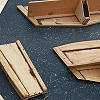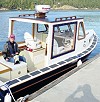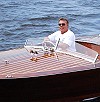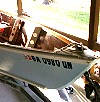

A place to share YOUR boat building story
Glen-L Marine Designs - 9152 Rosecrans Ave. - Bellflower, CA 90706
 In this issue
In this issue
-
A First-Time Boatbulder Shares by
Dean Toburen
-
Glen-L Boatbuilder of the
Month
-
Designer's Notebook: Stem
Caps
-
Spring by ArtDeco
-
Photos posted since the last
WebLetter...
-
Pennies
-
Shop Talk: Rule Guide & Band
Saw Shelf
-
Recent email
-
King Arthur's
Dilemma
GLEN-L Update
- Why Not Write Your Own Article for the Glen-L WebLetter?
- We would really like to include more articles, short stories, anecdotes, narratives and/or parables from you, our customers, readers and friends.
- Nothing enhances, enriches, (and often amuses) all who read the WebLetter more than hearing the actual, first-hand recounts of your trials, tribulations and triumphs! After all, Glen-L really is all about YOU, dreaming, scheming, planning, discovering, solving, building your perfect boat and then enjoying not only the use of your boat but also the admiring glances of all around when you proudly state "I built her myself!"
- You don't have to wait until your craft is 100% complete; if it is, all the better, but why not grab a pen and paper right now and just jot down a couple of thoughts about how you feel and see where it leads? You just might be surprised at what pours forth once you start!
Until next month . . .
Editor
A First-Time Boatbuilder Shares
by Dean Toburen
DEAN'S INITIAL REPORT ON BUILDING THE GLEN-L MONACO
I was unable to listen live to Bill Edmondson's Teleseminar but did
listen to the replay. I found it very informative and since I
am building the Monaco I understand his comments
regarding everything not needing to be perfect and why some
folks start but never finish.
Before I write about my boat building I would like to tell
you a little about my self. I retired on January 1, 2008 at
age 67. For some 13 years I worked as a Project Manager for a
company that designed and installed conveying systems. For
the last 20 years I worked as Regional Sales Manager for a
German company that manufactures large process equipment. Now
that I have retired I work about 25 hours a week at our local
ACE Hardware and consult for a local company 1 - 2 days per
week. As you can tell I am staying very busy but enjoying
every minute of it.
Since I don't play golf I spend a week in Canada every
year, fishing with a group that has been going for over 15
years now. I also spend a lot of time with our grandchildren
doing whatever they want to do at the time. I have my private
pilot's license but due to cost and time have not stayed
current.
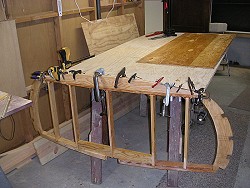 I started the boat in the winter of 2005.
The decision was to either build an airplane or a boat and I
decided that I would be safer in a boat, plus I could get my
wife to ride in the boat. The winter of 2005 was spent
cutting and fitting all the internal pieces. After everything
was cut I applied a coat of Epoxy-Plus and did a light
sanding. I then set up the fixture for assembling then glued
and nailed each internal frame together. After assembling I
gave each completed frame another coat of Epoxy-Plus. All the
internals were completed in early spring of 2006 and photo at
right shows the pieces setting on a ledge in my basement.
I started the boat in the winter of 2005.
The decision was to either build an airplane or a boat and I
decided that I would be safer in a boat, plus I could get my
wife to ride in the boat. The winter of 2005 was spent
cutting and fitting all the internal pieces. After everything
was cut I applied a coat of Epoxy-Plus and did a light
sanding. I then set up the fixture for assembling then glued
and nailed each internal frame together. After assembling I
gave each completed frame another coat of Epoxy-Plus. All the
internals were completed in early spring of 2006 and photo at
right shows the pieces setting on a ledge in my basement.
Glen-L Boatbuilder of the Month
Buddy Slack - Zip
by Margaret M. Lamb
THE MAN WHO NEVER BUILT A BOAT, NEVER EVEN NAILED TWO PIECES OF PLYWOOD TOGETHER…
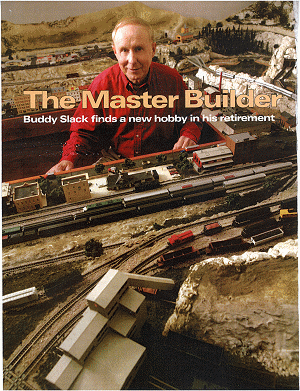 B uddy Slack of
Columbia, South Carolina, didn't get the retirement memo,
the one acknowledging his years of service and urging the
newly-minted retiree to buy a set of golf clubs, pick up the
fishing rod, find a hobby and just let the good times
roll.
B uddy Slack of
Columbia, South Carolina, didn't get the retirement memo,
the one acknowledging his years of service and urging the
newly-minted retiree to buy a set of golf clubs, pick up the
fishing rod, find a hobby and just let the good times
roll.
No. When he retired with the rank of colonel after 29 years
as a pilot in the U.S. Marine Corps, Buddy took an assignment
to launch the Navy Junior ROTC program at Chapin High School,
turning it into a two-time national champion.
And that's just his day job.
The man who never nailed two pieces of plywood together also
has channeled his energy and considerable talent toward
building a 1940's-era racing boat, as well as a replica
of three train lines that snaked through the eastern
Tennessee area where he grew up.
The boat building all started with an old family scrapbook
Buddy and his wife, Susan, found when they were going through
the belongings of his late fatter, Tom Slack, of Knoxville,
Tennessee.
That's when they saw the photos: larger than life, black
and white, capturing the golden era of boat racing in the
Southeast in the 1930s and '40s. They showed Tom, chemist
by day, racer on weekends, looking dashing behind the wheel
of a Century Whirlwind, his striking wife by his side.
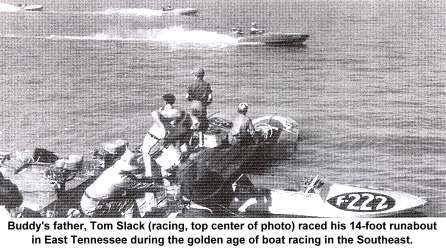
Never mind that he had never built a boat before, or anything else, for that matter.
Designer's Notebook: Stem Caps
|
SpringD ays are getting longerWeather is getting better Temps are moving higher No need for heavy sweaters Sunshine on the water A breeze just stirs the air Boaters gather at the shore As visitors to a country fair Boats come out of storage Hulls all clean and bright Children watch with anticipation And wonder at the sight Here are boats new built Ready for their very first ride With owners eagerly waiting Filled with hope and pride Boating season is upon us For fishing, skiing or just fun It’s time to get that boat out Don’t let me be the only one -ArtDeco |
Photos posted since the last WebLetter... |
Pennies
Have you been as puzzled as I have
by the sizing terms of "fourpenny,"
"sixpenny" and "tenpenny" as applied to
common nails?
Well, in our never-ending search to bring you, our readers,
helpful and (hopefully) interesting information, we ran
across a VERY old publication put out by the Ducommun Metals
& Supply Company which provided an interesting array of
useful (?) data, including "Ball Data,"
"Grades of Emery," "Rules for Finding Contents
of Vessels," "Bars and Plates," "General
Information" and "Pennies."
According to Ducommun, "fourpenny" means four
pounds to the thousand nails (i.e. 1000 nails of a certain
size would weigh 4 pounds), "sixpenny" means six
pounds to the thousand nails, and so on. It is an old English
term, and meant at first "ten pound" nails (the
thousand being understood), but the old English clipped it to
"tenpun" and from that it degenerated until
"penny" was substituted for
"pounds."
Next month, be sure to tune in to learn about "Ball
Data" . . .
 |
Shop Talk: Rule Guide
& Band Saw Shelf
Rule
Guide
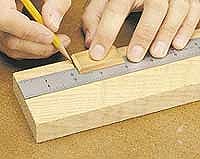
A good solution is the simple rule guide shown at right. It's a small wood block that makes it easy to accurately lay out a line. You simply align the end of the block with the desired increment on the rule. Then mark the line, using the block as a guide.
To allow the rule guide to sit flat on a workpiece, rabbet the bottom edge to fit over the metal rule (Figure 1). Since the rule guide is fairly small, it's best to cut this rabbet in an extra-long piece and then trim off the excess length (Figure 2).
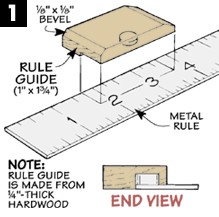
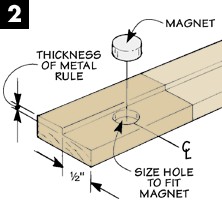
After cutting the rule guide to length, it's just a matter of sanding a bevel on each end to ease the sharp edges and then use epoxy to glue in the magnet.
Band Saw
Shelf
To provide clearance for the lower door of the band saw, the shelf is built up above the arm with a spacer block. To attach the spacer block, drill and tap the cast iron arm to accept a pair of machine screws (see detail).
With the spacer block in place, all that's left to do is to attach the shelf to the block with screws.
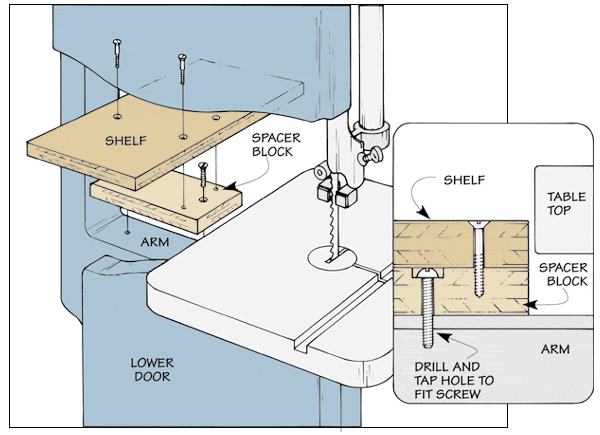
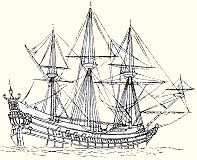
Recent email:
Subject: Malahini
Date: 11 March 2009
I finished my Malahini in December '08 and dunked
it in the water last week. Took it out for a ride today,
March 11. Great fun. Rides and handles nice. Does not go as
fast as I expected - I think I need to change the propeller -
a 9 X 13P. The motor is a 1982 Mercury 50hp.
It was great to finally get it out and well worth the time
and work(play) to build it. People followed me to the lake
and one guy wants me to build him a boat.
THANKS Glen-L for a great boat!!
-- Chris Hodgdon
Edgemoor, South Carolina
Subject: 1969 Tiny Titan
Date: 5 April 2009
Dear Glen-L Folks,
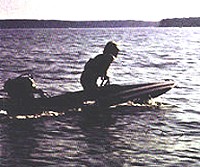 Just
thought I would drop you a fun note in these
“fun” times. First, I hope you are doing well in
the boat business. In 1969 my father and I built the Tiny Titan in our basement. I painted it
orange with a black strip down the middle and we purchased a
10 H.P. Chris-Craft outboard and installed it with a steering
wheel and dead-man’s throttle. Two years later I
painted it red, white, and blue. Many weekends were spent on
Hardy Dam Pond (the back waters of the Muskegon River near
Morely, Michigan) and Bass Lake near Traverse City, Michigan.
I felt pretty cool driving a boat that seemed fast at the
time, but slow compared in today’s standards (60 mph on
a jet ski?).
Just
thought I would drop you a fun note in these
“fun” times. First, I hope you are doing well in
the boat business. In 1969 my father and I built the Tiny Titan in our basement. I painted it
orange with a black strip down the middle and we purchased a
10 H.P. Chris-Craft outboard and installed it with a steering
wheel and dead-man’s throttle. Two years later I
painted it red, white, and blue. Many weekends were spent on
Hardy Dam Pond (the back waters of the Muskegon River near
Morely, Michigan) and Bass Lake near Traverse City, Michigan.
I felt pretty cool driving a boat that seemed fast at the
time, but slow compared in today’s standards (60 mph on
a jet ski?).
The boat was sold in approximately 1972 and in 1975 the
fellow that bought the boat approached me and said he had
never used it and wanted to give it back to me. I accepted
and it sat in the barn for the next 34 years. A buddy saw it
that owns a auto body shop, and his comment was,
“Let’s paint it.”
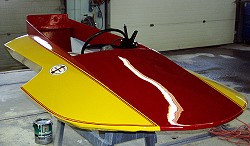 So here
it is 40 years later with a paint job that cost 10 times more
than the boat. It is so nice that I haven’t decided if
I should put it in the water or hang it off the wall as
art.
So here
it is 40 years later with a paint job that cost 10 times more
than the boat. It is so nice that I haven’t decided if
I should put it in the water or hang it off the wall as
art.
Hundreds of good memories were made in the building and
operating of this little boat. Thank you for inspiring my
father and me years ago with the brochure.
PS. I still have that too!
Thank you,
-- Mr. Kim Thomet
Hastings, Michigan
Subject: Boat Show Win
Date: 11 April 2009
Also just to let you know our "Bootlegger" won First Prize at the Seresin Antique and Classic Boat Show last weekend. This show is held at Lake Rotoiti in the South Island (we usually boat on Lake Rotoiti in the North Island). It's an 11 hour drive plus a ferry ride for us to get there and the lake is in the middle of a large conservation reserve with dramatic scenery.
The show is in its 10th year and from its beginnings of 35 boats there were approximately 180 boats there this year. We had a blast of a weekend.
Also the overall winner in 2005 was a lengthened Glen-L Squirt called “Babychamps”. I met a guy there (can't remember his name) who is well on the way with a Malahini.
Glen-L was talked about a lot over the weekend – most people I spoke to had at the least heard of you and had visited your website.
Keep up the good work
-- Greg Roy
Auckland, New Zealand
Press Release about Seresin Boat Show winner "Bootlegger"
More about "Bootlegger".
Subject: The Economy
Date: 10 April 2009
I am restoring a wooden boat and also building one of your Tugs and hope to start on an Airboat before the end of summer. Thanks for the WebLetter.
-- Jimmy Helms
Charlotte, North Carolina
Subject: Glen-L WebLetter
Date: 9 April 2009
Blessings on you and yours.
-- Joseph Nowell
P.S. About your Teleseminar: Thank you so very much for the replay... the second time through was even more enjoyable than the original broadcast. Your website is so informative...
 Subject: XP8
Subject: XP8
Date: 17 April 2009
Thanks, Glen-L!
-- Dave Rogalski
Safety Harbor, Florida
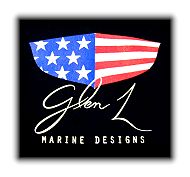
GLEN-L boats, of course
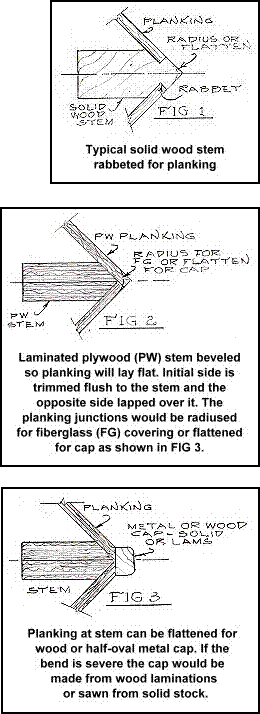 The old but tried and
true method was to rabbet the planking in the solid
wood stem (See Fig 1). The rabbet is at an ever
changing angle and is chiseled into the stem.
Accomplishing this is time consuming, and with the
advent of plywood became quite difficult. Fitting a
single plank in a rabbet isn't that difficult,
but fitting the large area required for sheet
plywood is very tedious and time consuming.
The old but tried and
true method was to rabbet the planking in the solid
wood stem (See Fig 1). The rabbet is at an ever
changing angle and is chiseled into the stem.
Accomplishing this is time consuming, and with the
advent of plywood became quite difficult. Fitting a
single plank in a rabbet isn't that difficult,
but fitting the large area required for sheet
plywood is very tedious and time consuming.










